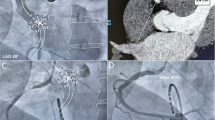Abstract
Introduction
Remote magnetic navigation (RMN) has been reported as an effective and safe tool to overcome the need for advanced operator skill in the treatment of complex arrhythmias. We report a series of patients undergoing radiofrequency catheter ablation of ventricular arrhythmias (VAs) using RMN with either a 4-mm catheter tip or an 8-mm catheter tip at four different centers.
Methods
Sixty-five patients with clinical and symptomatic history of Vas were included. Two different magnetic catheters were used to deliver radiofrequency applications remotely. When ablation with the RMN catheters failed, a manual irrigated catheter was used to eliminate the VAs. Post-ablation pacing maneuvers were utilized to verify the inducibility of Vas.
Results
Twenty-eight patients (43%) had ischemic cardiomyopathy [coronary artery disease (CAD)], 16 patients (25%) had non-ischemic cardiomyopathy [idiopathic dilated cardiomyopathy (IDC)], and 21 patients (32%) had structurally normal hearts (SNH) or right ventricle outflow tract tachycardia (RVOT). In patients with structural heart disease (CAD, IDC), success was achieved in 22% with the 4-mm catheter tip and in 59% with the 8-mm catheter tip (p = 0.014). In patients with SNH/RVOT, success was achieved in 85% with the 4-mm catheter tip and in 87% with the 8-mm catheter tip (p = 1.00).
Conclusions
Our findings showed that, with RMN, there is an increased success related to the catheter tip utilized. However, in patients with right ventricular outflow origin, the standard 4-mm tip provided adequate lesions for successful ablation in most patients.

Similar content being viewed by others
References
Soejima, K., Suzuki, M., Maisel, W. H., Brunckhorst, C. B., Delacretaz, E., Blier, L., et al. (2001). Catheter ablation in patients with multiple and unstable ventricular tachycardias after myocardial infarction: short ablation lines guided by reentry circuit isthmuses and sinus rhythm mapping. Circulation, 104, 664–669.
Marchlinski, F. E., Callans, D. J., Gottlieb, C. D., & Zado, E. (2000). Linear ablation lesions for control of unmappable ventricular tachycardia in patients with ischemic and nonischemic cardiomyopathy. Circulation, 101, 1288–1296.
Aryana, A., d'Avila, A., Heist, E. K., Mela, T., Singh, J. P., Ruskin, J. N., et al. (2007). Remote magnetic navigation to guide endocardial and epicardial catheter mapping of scar-related ventricular tachycardia. Circulation, 115, 1191–1200.
Di Biase, L., Fahmy, T. S., Patel, D., Bai, R., Civello, K., Wazni, O. M., et al. (2007). Remote magnetic navigation: human experience in pulmonary vein ablation. Journal of the American College of Cardiology, 50, 868–874.
Pappone, C., Vicedomini, G., Manguso, F., Gugliotta, F., Mazzone, P., Gulletta, S., et al. (2006). Robotic magnetic navigation for atrial fibrillation ablation. Journal of the American College of Cardiology, 47, 1390–1400.
Sosa, E., Scanavacca, M., D'Avila, A., Piccioni, J., Sanchez, O., Velarde, J. L., et al. (1998). Endocardial and epicardial ablation guided by nonsurgical transthoracic epicardial mapping to treat recurrent ventricular tachycardia. Journal of Cardiovascular Electrophysiology, 9, 229–239.
Schweikert, R. A., Saliba, W. I., Tomassoni, G., Marrouche, N. F., Cole, C. R., Dresing, T. J., et al. (2003). Percutaneous pericardial instrumentation for endo-epicardial mapping of previously failed ablations. Circulation, 108, 1329–1335.
Arenal, A., del Castillo, S., Gonzalez-Torrecilla, E., Atienza, F., Ortiz, M., Jimenez, J., et al. (2004). Tachycardia-related channel in the scar tissue in patients with sustained monomorphic ventricular tachycardias: influence of the voltage scar definition. Circulation, 110(17), 2568–2574.
de Chillou, C., Lacroix, D., Klug, D., Magnin-Poull, I., Marquie, C., Messier, M., et al. (2002). Isthmus characteristics of reentrant ventricular tachycardia after myocardial infarction. Circulation, 105(6), 726–731.
Reddy, V. Y., Neuzil, P., Taborsky, M., & Ruskin, J. N. (2003). Short-term results of substrate mapping and radiofrequency ablation of ischemic ventricular tachycardia using a saline-irrigated catheter. Journal of the American College of Cardiology, 41, 2228–2236.
Burkhardt, J. D., Saliba, W. I., Schweikert, R. A., Cummings, J., & Natale, A. (2006). Remote magnetic navigation to map and ablate left coronary cusp ventricular tachycardia. Journal of Cardiovascular Electrophysiology, 17, 1142–1144.
Koektuerk, B., Chun, J. K. R., Schmidt, B., Metzner, A., Tilz, R., Koster, I., et al. (2008). Remote controlled catheter ablation of typical atrial flutter: a preliminary comparison of the magnetic 8 mm tip catheter versus the novel 3.5 mm irrigated tip magnetic catheter. Heart Rhythm, 5(5, Suppl S118), 1–47. Abstract.
Sapp, J. L., Cooper, J. M., Zei, P., & Stevenson, W. G. (2006). Large radiofrequency ablation lesions can be created with a retractable infusion-needle catheter. Journal of Cardiovascular Electrophysiology, 17, 657–661.
Dorwarth, U., Fiek, M., Remp, T., Reithmann, C., Dugas, M., Steinbeck, G., et al. (2003). Radiofrequency catheter ablation: different cooled and noncooled electrode systems induce specific lesion geometries and adverse effects profiles. Pacing and Clinical Electrophysiology, 26, 1438–1445.
Author information
Authors and Affiliations
Corresponding author
Rights and permissions
About this article
Cite this article
Di Biase, L., Burkhardt, J.D., Lakkireddy, D. et al. Mapping and ablation of ventricular arrhythmias with magnetic navigation: comparison between 4- and 8-mm catheter tips. J Interv Card Electrophysiol 26, 133–137 (2009). https://doi.org/10.1007/s10840-009-9416-5
Received:
Accepted:
Published:
Issue Date:
DOI: https://doi.org/10.1007/s10840-009-9416-5




